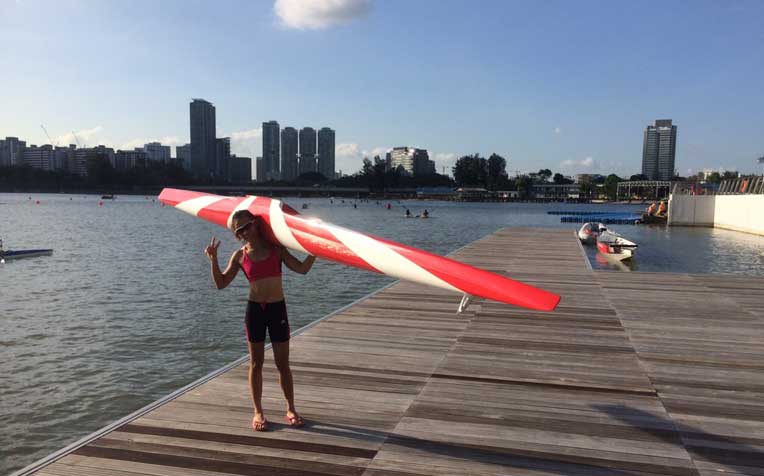
Eating well on a sugar-free and gluten-free diet requires careful monitoring.
Suzanne Seah, 24, had never participated in any form of sport until she took up kayaking at the age of 17. Today, she’s a Team Singapore athlete, proudly representing the country in international kayak competitions.
And for the last two years, she’s done all of this on a sugar-free and gluten-free diet.
What’s a day in the life of Suzanne Seah like? She wakes up at about 5am, makes breakfast and goes for a gruelling morning training session. She goes back home for lunch, reads a bit or sometimes catches a quick nap, then heads back for her afternoon training session. In the evenings, she rests.
The only day she doesn’t train is Sunday. She might go to the cinema with her boyfriend, but mostly, she rests and sleeps in. Throughout the week, the vivacious young woman clocks in well over 20 hours of intense physical activity, all the while being on a strict sugar-free and gluten-free diet.
“I went sugar-free first. My coach suggested I cut out sugar and bread to lower my body fat,” says Suzanne. She did not just eliminate white sugar. The diet targeted all simple sugars, such as honey. Low-fiber, simple-carb breads, buns and even white rice were also taken off her diet. It worked – her body fat was reduced by 8 per cent.
Suzanne then started doing a lot of research on nutrition and found out more about gluten, the protein that’s found in most food staples in Singapore, such as breads and wheat-based noodles.
Though she does not have coeliac disease (an autoimmune reaction to gluten that results in damage to the small intestine and distressing gastrointestinal symptoms), Suzanne thought she would experiment with a gluten-free diet to see if it would help her with her irritable bowel syndrome (IBS). It did, and she’s kept at it ever since.
“A nutritionist follows me to make sure I eat enough. On a sugar-free and gluten-free diet, you can end up eating not enough calories if you don’t pay attention,” says Suzanne. To illustrate this, think of how easy it is to eat a bowl of white rice. It would be difficult to finish an equivalent amount of black rice because of the high-fibre content.
| Fact Sheet on Suzanne Seah | |
|---|---|
| Personal data : | 24 years old, single |
| Occupation : | Full-time athlete (kayaker) |
| Hobbies : | Reading fiction, especially sci-fi |
| Pets : | Cavalier King Charles spaniel dog, named Sophie |
| Little-known fact : | She can do 57 chin-ups in one go |
What are your best 3 tips for people who wish to follow a sugar-free, gluten-free diet like you?
-
Adopt the right mindset
Whether a restrictive diet is ‘forced’ on you, as in the case of people with true coeliac disease, or whether you think it’s best for you, it will be difficult to keep it up if you don’t have the right mindset. Tell yourself that you’re making a conscious choice to eat better. Be positive about it. It can be fun to make bread and cakes from almond or coconut flour, for instance. There are so many alternatives. You’ll soon realise that you can make pretty good food. This diet is not tasteless like many people think.
-
Realise that sugar and gluten are hidden everywhere
Take gluten for instance. Even potato chips have gluten in them, unless the packaging says otherwise. Gluten is in ketchup, pretty much all sauces and marinades, and most likely even in the cooked chicken that you buy at the supermarket. You need to do your research, or you can ask a qualified nutritionist for advice if you’re unsure. You’ll find out that there are a lot of things you can’t eat, but there is an equal amount of delicious foods you can. It opens up your food horizons.
-
Be prepared for eating out situations
Before eating out with friends, I always research the restaurant menu. If I suspect that my sugar-free, gluten-free options will be limited or non-existent, I may eat something before going. I always keep some food with me, such as sweet potatoes, hard boiled eggs, almonds or fruits, so I can have a quick bite in case something gets organised at the last minute. I will still enjoy good company, without needing to compromise or go hungry. I prefer not to make myself stand out, so I will plan instead of making a big deal of my diet once at the restaurant. Last advice: Remember that you don’t have to explain yourself. You can just state what you WANT to eat. If you start listing what you can’t eat, you will find it quickly exhausting to answer a barrage of “whys”. Bottom line is, you don’t have to eat anything to please anyone. It’s your body.
Ref: Q15
Contributed by


















 Get it on Google Play
Get it on Google Play